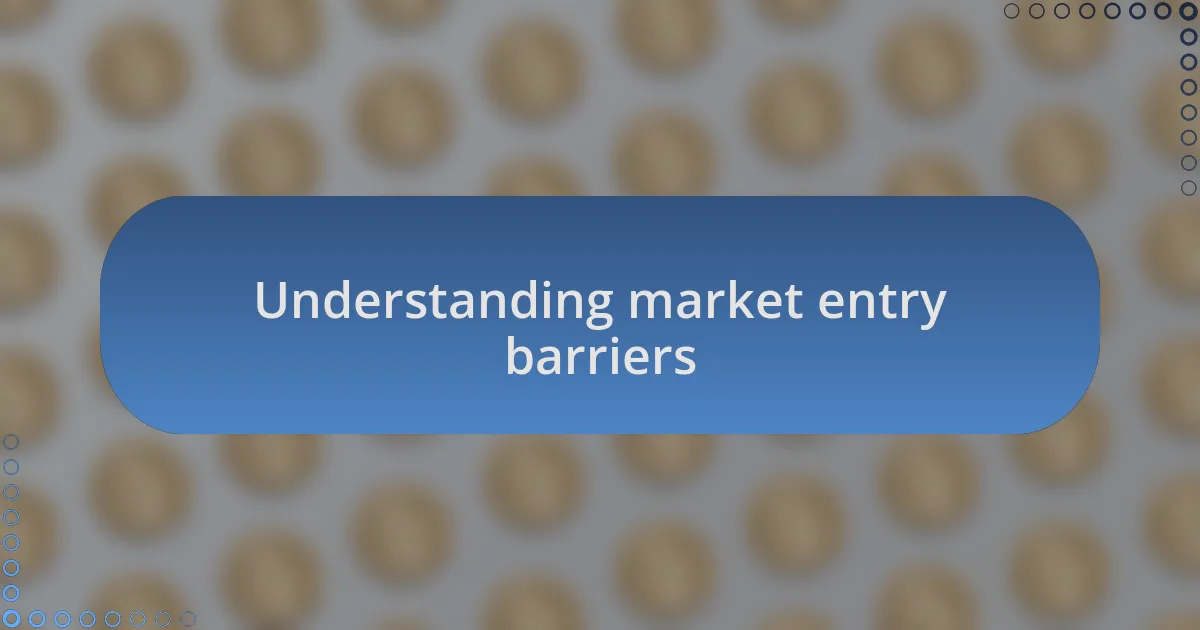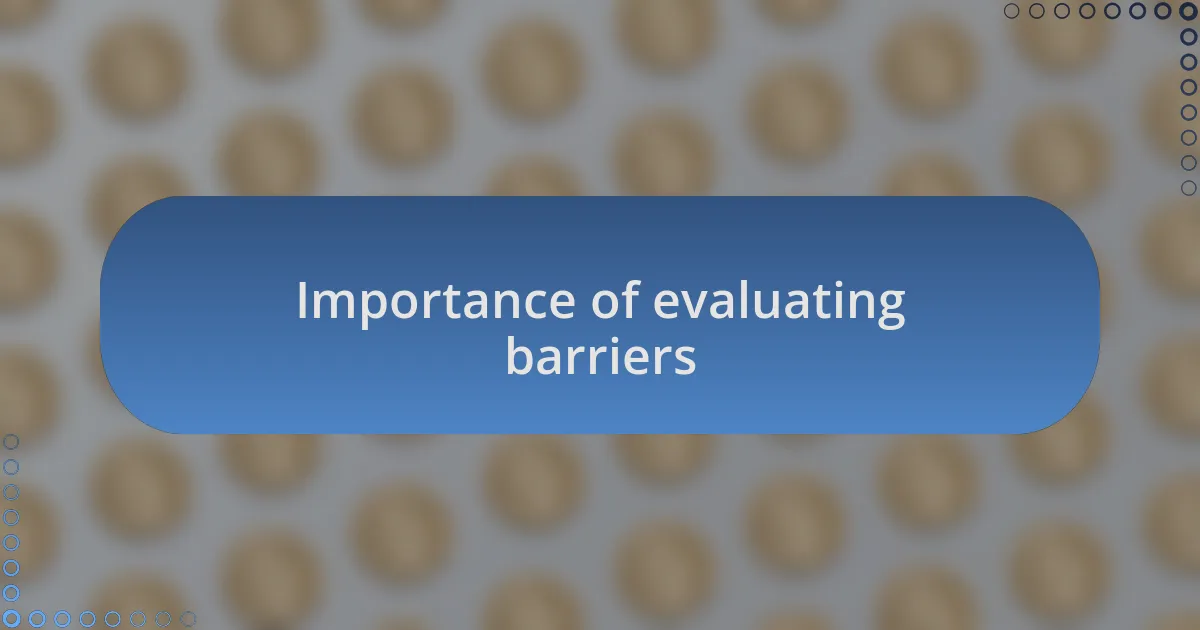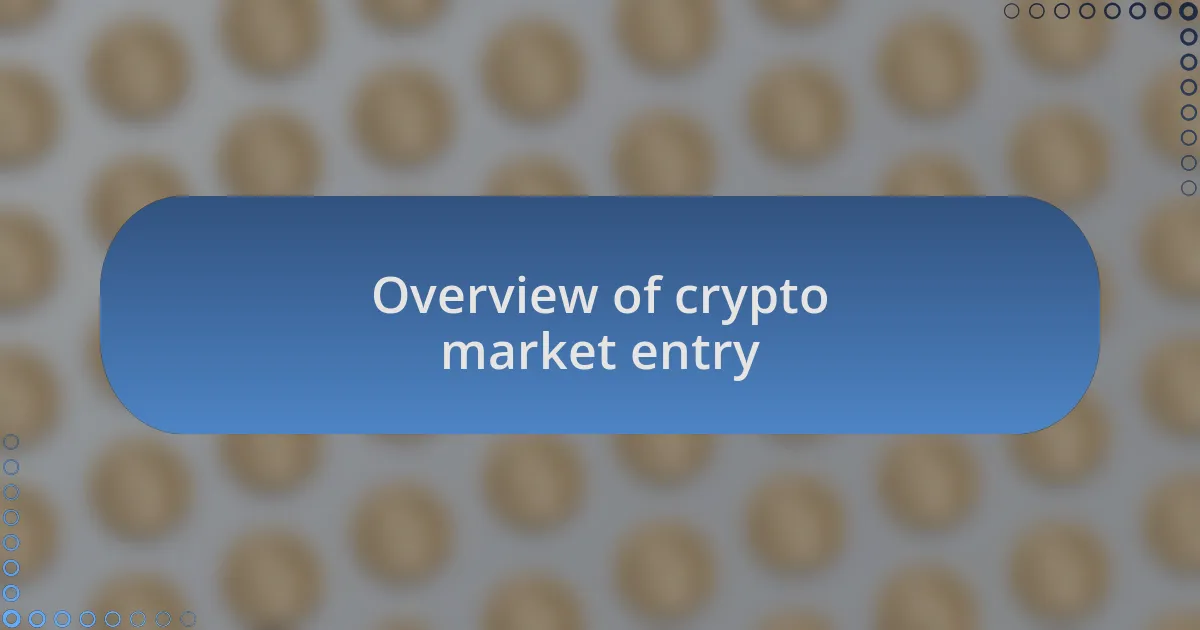Key takeaways:
- Understanding market entry barriers is crucial, including regulatory challenges, technology needs, and existing competition.
- Evaluating barriers involves analyzing not only financial aspects but also customer perceptions and market timing.
- Utilizing analytical tools like SWOT analysis and sentiment analysis can enhance the evaluation of market entry strategies.
- Learning from case studies highlights the importance of adapting strategies to local markets and user needs for successful entry.

Understanding market entry barriers
Market entry barriers refer to obstacles that make it challenging for new entrants to compete in an industry. From my experience, understanding these barriers is essential for anyone looking to navigate a complex market landscape. For instance, I once encountered significant hurdles when analyzing a new cryptocurrency platform’s entrance into a saturated market. The existing players had built not only strong brand loyalty but also formidable ecosystems that seemed impenetrable.
Regulatory requirements can be a particularly tricky entry barrier, often requiring in-depth knowledge of legal frameworks that vary from one region to another. I remember a time when I realized that not all regulations were the same; some meant navigating a labyrinth of compliance that could stifle innovation. Do you think the potential rewards outweigh these regulatory challenges? I’ve often found that diligent research and proactive strategies can turn these challenges into opportunities for differentiation.
Another barrier worth considering is technology and infrastructure. Many aspiring businesses underestimate the resources needed to build the necessary systems for efficient operations. When I delved into blockchain technology for the first time, I was amazed at how much expertise and investment were required to create a secure and scalable platform. It made me question: are you truly prepared to invest in the technology that will set you apart, or are you relying on assumptions? This reflection can be a game changer in determining your approach to market entry.

Importance of evaluating barriers
Evaluating market entry barriers is crucial for understanding the competitiveness of a new venture. When I first analyzed a potential investment in a blockchain startup, I discovered that the barriers were not just financial. They included customer apprehension due to volatility in the crypto market. This realization hit home; it’s essential to quantify not just the barriers but the attitudes associated with them.
Consider the importance of network effects, which can heavily influence market dynamics. I recall a project that aimed to disrupt a well-established cryptocurrency. While the technology was promising, it lacked the user base that offered security and engagement. This experience taught me that sometimes, it’s not about having the best product but about how many people are already committed to the existing solutions. Have you thought about what it takes to build a community around your offering?
Lastly, the importance of timing can’t be overstated. I once missed out on an investment opportunity because it appeared too late to the market. By failing to evaluate the existing landscape and timing, I overlooked the fact that market conditions can either favor or hinder entry efforts. Reflecting on these experiences has driven home the point that a deep understanding of barriers must involve analyzing not just what exists, but how and when to navigate them effectively.

Overview of crypto market entry
Entering the crypto market can be both thrilling and daunting. In my experience, understanding the regulatory landscape has been one of the most challenging aspects. When I set out to evaluate a new cryptocurrency initiative, I can’t ignore how different jurisdictions have varying stances on crypto legality, often creating a maze of compliance requirements that can trip up even seasoned entrepreneurs.
One factor that often surprises newcomers is the fierce competition and the pace of innovation. I remember evaluating a promising project that aimed to implement smart contracts. While it was technically sound, I found myself thinking, “How will it stand out in a sea of similar solutions?” This question kept me engaged as I explored how differentiation could be the key to successfully penetrating the market.
Additionally, I often reflect on the role of user trust in the crypto space. The emotional aspect of this market is palpable; after all, people are investing not just their funds but their confidence in a system that is still relatively young. Early on, I learned firsthand about the importance of building a trustworthy brand, especially when potential users are weighing their options. Navigating these market entry complexities requires not just a strategy but a genuine connection with the community you aim to serve.

Tools for analyzing barriers
When it comes to analyzing barriers to market entry, I’ve found that leveraging analytical tools can significantly enhance decision-making. For instance, utilizing platforms like SWOT analysis can help identify strengths, weaknesses, opportunities, and threats specific to the crypto space. I remember employing this method during a project assessment; it illuminated not just the risks but also underlying opportunities that I hadn’t initially recognized.
Another resource I regularly turn to is market research databases, such as CoinMarketCap or Statista. They provide invaluable data on crypto trends, user demographics, and competitor performance. I still recall reading a report about user behavior that sparked new ideas for outreach strategies—I couldn’t believe how much insight data could provide. Have you ever thought about how numbers alone could steer your project in a different direction?
Lastly, sentiment analysis tools have become indispensable in my evaluations. They help gauge public opinion and community interest surrounding different cryptocurrencies. I distinctly remember tracking Twitter sentiments during a product launch—observing the reception in real-time not only reshaped our marketing approach but also reinforced the importance of community feedback. This made me ponder: how well are you listening to your audience?

Personal evaluation methods
When I evaluate market-entry barriers, I often turn to my personal framework, which revolves around core questions that guide my analysis. For example, I ask myself, “What are the regulatory challenges I might face?” Reflecting on an experience with a blockchain startup, digging deep into legal compliance showed me just how different regulations could shape our approach and potential for success.
Another method I favor is qualitative feedback, especially from industry peers and potential users. Engaging them in conversations—sometimes even casual chats at networking events—has revealed insights I never anticipated. I recall discussing a project over coffee, and a simple question about user experience led to major shifts in our design and strategy, highlighting how vital it is to listen to the market.
Lastly, I often conduct comparative assessments across similar projects. This involves analyzing not just their successes, but also their missteps. I remember dissecting a failed market entry strategy, which opened my eyes to the importance of adaptability. Have you noticed how learning from others’ setbacks can save you from making the same mistakes? It’s a powerful reminder of the value in thorough evaluation.

Case studies of market entries
Exploring case studies of market entries can be incredibly illuminating. I once analyzed a well-known cryptocurrency exchange that attempted to expand into Asia. They launched with confidence, only to realize that they had underestimated the local nuances in regulations and user behavior. This experience underscored for me the crucial need for tailoring strategies to fit specific markets.
Another case that sticks with me is a decentralized finance (DeFi) project that sought to penetrate European markets. Initial presentations highlighted their cutting-edge technology, but they had to pivot when they faced fierce competition and regulatory scrutiny. This taught me that innovation alone doesn’t guarantee success; sometimes, understanding the competitive landscape and adjusting your market entry tactics is essential. Have you thought about how perception can influence market entry success?
In a more personal instance, I’ve consulted for a startup eyeing entry into South America. We scoured market reports and conducted interviews, leading us to discover that user education was a significant barrier. Adapting our approach to include educational workshops drastically improved our chances. It just goes to show that direct engagement with potential users can reveal obstacles that aren’t always evident on paper.